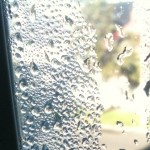Condensation

Condensation, a minor inconvenience, or a major problem?
A little condensation on windows is easily dealt with, . . . . . . but heavy condensation in poorly ventilated corners can lead to mould damaging your walls, ceilings, or even your clothes.
Why does Condensation Occur
Condensation in a building occurs when warm air, containing water vapour, comes into contact with a cold surface.
As the air cools it can’t hold as much water vapour so the excess changes into liquid water which is deposited on the cold surface.
The water usually appears as surface condensation as water droplets or water film on cold surfaces, typically windows.
Condensation occurring on cold walls and ceilings is a major issue as it is when mold problems start. Of particular risk are wardrobes on an external wall as there is a cold surface and a lack of ventilation.
Sources of Water
Here are five main sources of water vapour in the home
- People – A typical adult will lose around 0.8L/day of water, half from skin evaporation, and half from breathing.
- Bathrooms – Not just the obvious showers and baths, its also those drying towels and bathrobes
- Kitchen – Kettles, Pans, dishwasher, and the microwave will add water vapour
- Un-Flued Combustion – Portable Gas Heaters, Gas Hobs, Bio Ethanol Heaters, even Candles, all emit water vapour into the room as they burn.
- Laundry – Unvented Tumble driers, Airing Clothes.
- Evaporative Cooling – Because it is mainly used in summer less of a problem, but can be an issue on cold nights.
Preventing Condensation Damage
Action to prevent condensation damage involves looking at both insulation and ventilation.
Insulation. Additional insulation in walls or ceiling will keep those surfaces warmer which will reduce the risk of condensation damage in most rooms .
Ventilation In bathrooms and kitchens the more moisture laden air means that insulation by itself will not be enough. The moist air needs to be effectively extracted to prevent condensation being an issue. (Although I have previously posted about Heat Loss due to Ventilation some ventilation is needed throughout the house)
Role of Double Glazing
Double glazing is often suggested as an answer to condensation however this is not really the case. As the windows are now less cold there is less surface condensation on the windows, so it looks like the issue has gone away. The problem is that without removing the moisture laden air the risk of condensation on walls and ceilings is increased.
See this link to find out why I prefer a separate Extraction fan in the Bathroom: 3 in 1 Bathroom Heaters
To keep moisture out of the insulation materials see this link: Vapour Barriers
It is theoretically possible to avoid condensation by adequate ventilation. In certain areas of a house (such as bathrooms and kitchens) the warm air contains a lot of moisture, if that air then spreads to cooler parts of the house, it will condense on any colder surface.
I definitely agree about extracting moisture at source for kitchens and bathrooms. As mentioned in the post there are other sources.
Brian